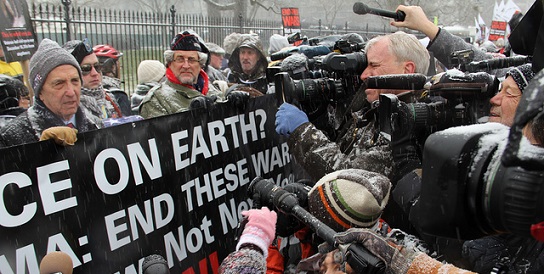In the context of the recent US election, a lot of conversations are happening about the way different forms of media impact people’s perceptions and behaviors. Similarly, discussions around increasing civic engagement are more and more common and pressing. However, while we know that news coverage and social media build energy around social movements, there is little research on how different kinds of media role modeling could encourage collective action—coordinated efforts made together with a group of different people working on the same issue.
In a recent set of studies, Bilali, Vollhardt, and Rarick (2017) demonstrated the impact of listening to a fictional radio program that depicted inclusive collective action—including creating petitions, organizing protests, starting service organizations, etc. These depictions—which explicitly included people from different ethnic groups—increased listeners’ sense of the potential power of collective action, their individual beliefs in their ability to make an impact, and their willingness to take part in collective action themselves.
While these findings suggested the potential positive impact of modeling collective action, they also found that listeners showed less tolerance for diverging opinions, less openness to working across different groups for social change, and more negative views of viewpoints outside of their own after they heard the program. The authors helped explain this somewhat surprising finding by pointing out the differences—and potential tensions—between collective action and prejudice reduction. While collective action focuses on raising awareness of issues and channeling the energy of conflict for change, prejudice reduction focuses on improving intergroup attitudes to reduce conflict. In addition to embodying different orientations toward conflict, collective action stimulates heightened in-group identity awareness while prejudice reduction seeks to dampen it.
This study holds important findings about the potential impacts and unintended consequences of media-modeled collective action efforts. The fact that the radio program made people feel more empowered to act and also less tolerant of other views is a valuable insight for practitioners of social change. Interventions to increase social activism might be wise to both model action and, in parallel, actively resist reinforcing negative intergroup biases. Given that interventions to increase energy for action might also increase people’s awareness of difference, practitioners should think creatively about how to address these dual forces if they seek to model constructive collective action.
Bilali, R., Vollhardt, J. R., & Rarick, J. R. D. (2017). Modeling collective action through media to promote social change and positive intergroup relations in violent conflicts. Journal of Experimental Social Psychology, 68, 200-211.
Photo Credit: Collin Anderson
 This work is licensed under a Creative Commons Attribution-NonCommercial-ShareAlike 4.0 International License.
This work is licensed under a Creative Commons Attribution-NonCommercial-ShareAlike 4.0 International License.
